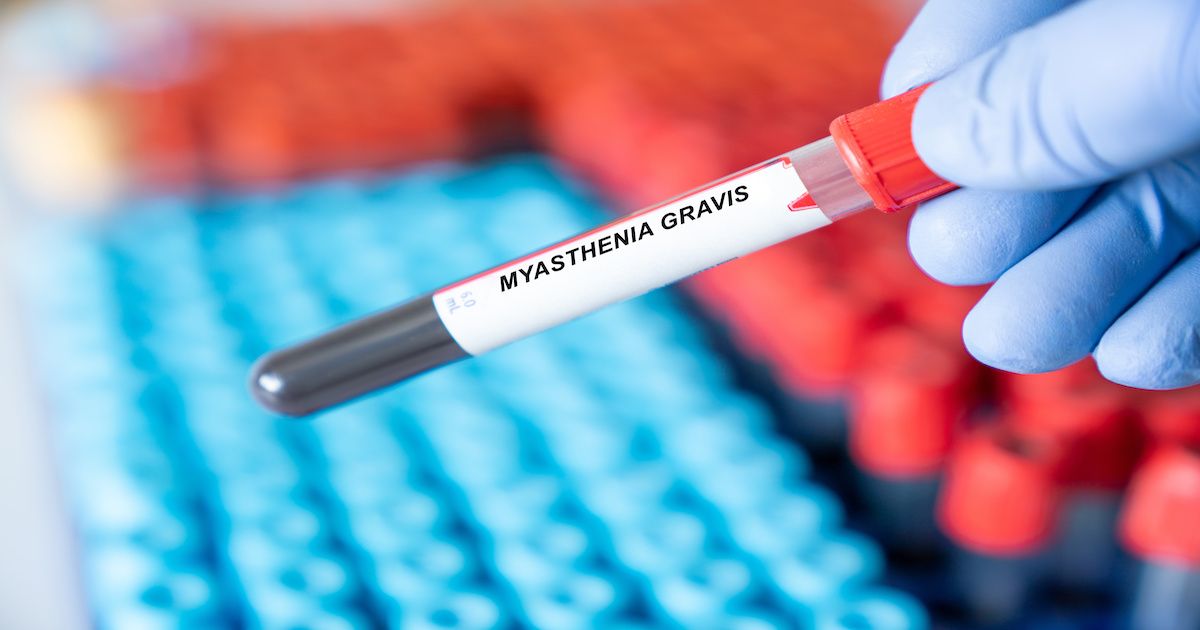- Center on Health Equity & Access
- Clinical
- Health Care Cost
- Health Care Delivery
- Insurance
- Policy
- Technology
- Value-Based Care
Phase 2 Results Show Safety, Dose-Dependent Improvements in Function With Nipocalimab in gMG
Based on data from the study, a phase 3 confirmatory trial is underway for the humanized monoclonal antibody.
Data from a midstage study support the use of nipocalimab in patients not responding to standard of care therapy for their general myasthenia gravis (gMG).
The findings from the multicenter Phase 2 study, published in Neurology, showed that the treatment was generally safe and well tolerated in patients, with no deaths, discontinuations due to treatment-emergent adverse events (TEAEs), or Grade 3 TEAEs of special interest, including infection or hypoalbuminemia—the study’s primary safety endpoint.
Based on data from the study, a phase 3 confirmatory trial is underway for the humanized monoclonal antibody.
Myasthenia gravis blood test | Image credit: luchschenF - stock.adobe.com

“Nipocalimab is engineered to remove immune effector functions including Fc gamma receptor and complement binding due to an aglycosylated Fc,” wrote the researchers. “In the first-in-human phase 1 study, nipocalimab demonstrated rapid, dose-dependent reduction of IgG up to 85% following single and weekly dosing, with mild or moderate adverse events, no serious adverse events or deaths, and low incidence of infection-related adverse events that were comparable with placebo treatment.”
In these most recent findings from the Phase 2 study—dubbed Vivacity-MG—68 patients were randomized to receive IV placebo every other week or one of 4 nipocalimab doses during the 8-week treatment period: 5 mg/kg every 4 weeks, 30 mg/kg every 4 weeks, 60 mg/kg every other week, or a single 60 mg/kg.
Across all 4 nipocalimab arms, rates of TEAEs (83.3% vs 78.6%, respectively) and infections (33.3% vs 21.4%, respectively) were similar to those observed in the placebo group. The most frequently reported TEAEs among patients receiving nipocalimab were diarrhea, headache, and nasopharyngitis, each occurring in 11% of patients.
Data from the study’s primary efficacy endpoint—change in the impact of gMG on daily functions from baseline to day 57—showed a significant dose response, with a statistically significant linear trend for the placebo, 5 mg/kg, 30 mg/kg, and 60 mg/kg regimens. Change in ability to perform daily functions was assessed using the Myasthenia Gravis-Activities of Daily Living total scores.
The researchers observed mild dose-dependent decreases in mean serum albumin for patients receiving nipocalimab. Among patients receiving the treatment at the highest dose, mean albumin decreased by 0.83 g/dL, with levels at baseline returning by the end of the additional 8 weeks of follow-up.
“The hypothesis-generating secondary and exploratory endpoints had some interesting results,” explained the researchers. “Single-dose 60 mg/kg of nipocalimab showed the greatest reduction in MG-ADL through day 29 and declined thereafter, indicating the clinical effect of a single dose may not extend beyond 1 month. Duration of MG-ADL reduction was consistent with the duration of PK exposure and IgG lowering, which were dose dependent and dose-frequency dependent.”
Regardless of dose, a greater proportion of patients receiving nipocalimab than receiving placebo achieved a durable response through day 57 according to MG-ADL. Nipocalimab did not yield significant improvements over placebo in Quantitative Myasthenia Gravis and Myasthenia Gravis Quality of Life -15 assessments, though the researchers noted that the COVID-19 pandemic created disruptions in study assessments.
Initiated at the tail end of 2018, the study dose its first patient in 2019 and continued to enroll and treat patients until April 2020, when drug administration was suspended due to the pandemic. While data continued to be collected, 14 patients either missed or delayed various assessment visits. There were 7 nipocalimab-treated patients who discontinued treatment early, all either due to the pandemic or violation of exclusion criteria.
Reference
Antozzi C, Guptill J, Bril V, et al. Safety and efficacy of nipocalimab in patients with generalized myasthenia gravis. Neurology. Published online December 21, 2023. doi: 10.1212/WNL.0000000000207937
